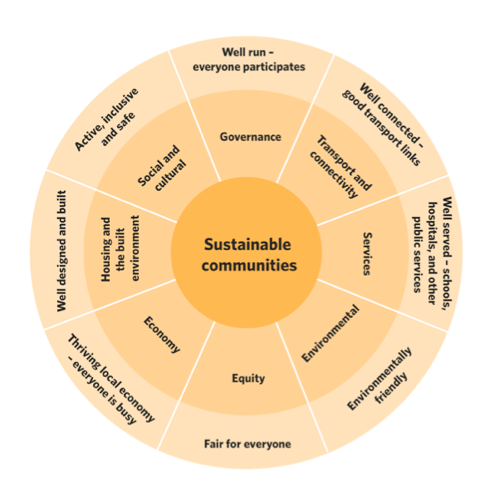Making rural places to live and work
What makes a community sustainable? It is a question that sits at the heart of government policy and practitioner debates – the responses of which have very real consequences for rural residents and places. Jessica Sellick investigates.
The notion of sustainable communities leaves much for decision makers and communities to think about. But ‘what makes a community sustainable’ and ‘can a Social Return on Investment analysis act as a catalyst for [rural community] action and investment’?
What is a sustainable community? The concept of a ‘sustainable community’ was first articulated by Government in 2003 by the then deputy Prime Minister John Prescott. In ‘Building for the future‘ – a £38 billion plan for economic, social and community development – the Labour administration set out how it intended to tackle the need for more affordable housing and improve the quality of life in communities by increasing prosperity, better public services, health and education. Here, communities were regarded as sustainable if they were ‘standing on their own feet and adapting to the changing demands of modern life. Places where people want to live and will continue to want to live’ (page 5).
Subsequently, in 2004, Sir John Egan posited that sustainable communities should meet ‘the diverse needs of existing and future residents, their children and other users by offering choice’. He suggested that to be sustainable, communities must: (i) make effective use of natural resources, (ii) enhance the environment, (iii) promote social cohesion and inclusion, and (iv) strengthen economic prosperity. Egan set out his framework for sustainability in a wheel:
The Egan Wheel
Source: John Widdowson, Geographical Association.
This policy work was taken up at a European level in 2005/2006, with The Bristol Accorddescribing a common European approach to sustainable communities comprised of 8 characteristics and a commitment to develop a bank of good practice case studies.
Between 2007 and 2009 the now defunct Sustainable Development Commission‘s (SDC) redefining prosperity project considered the connections and conflicts between sustainability, well-being and growth. This led to the publication of a report by Tim Jackson, ‘Prosperity without Growth? The transition to a low carbon economy‘. Here, Jackson acknowledged economic recovery was vital and protecting/creating jobs essential, but that this should be accompanied by a renewed sense of shared prosperity and a commitment to fairness and flourishing in a finite world. Jackson’s vision, therefore, was for a more local, less consumption driven approach to economic development whereby communities would in turn become more resilient.
Yet ‘Mind the Skills Gap‘, a report from the Academy for Sustainable Communities identified a shortage of qualified professionals with the necessary skills to actually deliver the previous Government’s agenda for sustainable communities.
In 2010, the Rural Coalition, which is supported and advised by the RSN, published ‘The Rural Challenge‘. This document presented a shared policy agenda for achieving sustainable rural communities, with the concept framed around ‘meeting the challenges of the environment, climate change and community cohesion’.
The Coalition Government’s Rural Statement 2012 called for businesses to make a ‘sustainable contribution to national growth’ and for ‘communities to access public services’ and to ‘be actively engaged in shaping the places where they live’. The Department for Communities and Local Government (DCLG) is tasked with leading the drive to transfer power so people can make more decisions locally, solve problems and create thriving neighbourhoods – from exercising rights to ‘bid, challenge and build’ to preparing neighbourhood plans. Defra, on the other hand, in tune with the Government’s top priority of driving economic growth, is undertaking a broad range of activities – from the establishment of five rural growth network pilots, to a Rural Broadband Programme and Mobile Infrastructure Project.
This timeline of ‘sustainable communities’ from 2003 to the present day is important for three reasons. Firstly, it illuminates the lack of a common understanding of sustainable communities. Whilst the foundations were created in 2003, these are now somewhat shaky, with sustainable communities subsumed into a drive for economic growth and thriving neighbourhoods. Secondly, is there a lack of technical skills and community capacity to develop this understanding? Community development, economic development and environmental officer roles have all been impacted by public sector funding reductions. Equally, enabling people to participate in their community and learn from their experiences requires time, money and skills on the part of rural residents, the organisations that support them and in the delivery of services. Thirdly, is the clock now ticking in terms of delivery? In the words of Matthew Taylor, is much of the countryside becoming part dormitory, part theme park and part retirement home? And if so, what can be done to reverse this trend?
This plethora of information on sustainable communities demonstrates that are many things we value that cannot easily be captured in economic terms. Can Social Return on Investment (SROI) act as a catalyst for [rural community] action and investment? SROI is a tool for measuring and accounting for social, economic and environmental factors beyond simple costs and price. There are six stages in a SROI process:
1. Establishing scope and identifying key stakeholders to identify impacts.
2. Mapping project outcomes with stakeholders.
3. Evidencing project outcomes and giving them a financial value.
4. Establishing project impact – accounting for deadweight and displacement.
5. Calculating the SROI.
6, Reporting the findings from the assessment process.
Taking the principles of the Egan Wheel as a starting point, it is possible to use SROI methodology to understand and maximise the social value an activity creates.
At a practical level, this approach has been used by Rose Regeneration to ascribe value to the wider social impacts of Farmer Networks, demonstrating how a return of £4.78 was generated for every £1.00 invested in the Hill Farming Succession Scheme in Cumbria, an initiative to help engage young people in agriculture.
This illustrates how farmer networks make both farmers and communities more sustainable; delivering significant returns to both their members/participants in the scheme (e.g. providing them with extracurricular activities linked to their package of training; gaining employment upon completion of the scheme) and the public purse (i.e., increased involvement of local people in volunteering, sustaining and developing farm businesses).
Understandings of sustainable communities and the use of SROI both bring to the fore the importance of measuring the impact and value of policy decisions. For how aspirations are interpreted and then find their way into concrete initiatives, with targets set and resources allocated, affects whether we are making rural communities truly sustainable or merely turning them into ghost settlements.
To explore the issues raised here further, the RSN is holding an event on sustainable communities on 10 September at Bishop Lloyd’s Palace Chester. The day will include presentations from Mick Duggan (DCLG Decentralisation and Neighbourhood Planning Team) on ‘Progress to Date with Neighbourhood Planning’ and Roy Alexander (University of Chester) considering ‘how rural parishes can go carbon neutral’. Four interactive workshop sessions will be running over the course of the event: (1) rural proofing, (2) localism for Town and Parish Councils, (3) alternative service delivery and (4) community asset mapping. The event is free but places are limited. For more information and/or to book your place please contact Wendy by email wendy.cooper@sparse.gov.uk.
Jessica is a researcher/project manager at Rose Regeneration; an economic development business working with communities, Government and business to help them achieve their full potential. She is currently providing Defra with examples of where ‘Big Society’ initiatives are working well and undertaking Leader programme evaluations in Cumbria, Yorkshire and Scotland. Jessica recently completed a piece of research for Oxfam on farm poverty, a National Review of Leader for Defra and prepared a Rural Economy Planning Toolkit for Leicestershire Rural Partnership. Jessica is experienced in a range of economic evaluation tools – including Benefit Cost Analysis, Economic Impact Analysis, Financial Analysis/Feasibility, Value-for-Money and Social Return On Investment. She can be contacted by email jessica.sellick@roseregeneration.co.uk or telephone 01522 521211. Website: http://www.roseregeneration.co.uk/ Twitter: @RoseRegen


